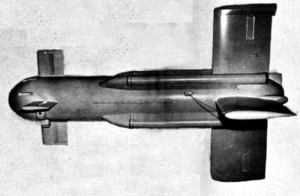KAN Little Joe
| KAN Little Joe | |
|---|---|
 | |
| Type | Surface-to-air missile |
| Place of origin | United States |
| Service history | |
| Used by | United States Navy |
| Production history | |
| Designed | 1945 |
| Manufacturer | |
| Produced | 1945-1946 |
| No. built | 15 |
| Specifications (KAN-1) | |
| Mass | 1,210 pounds (550 kg) |
| Length | 11 feet 4 inches (3.45 m) |
| Diameter | 22.7 inches (57.7 cm) |
| Warhead | High explosive |
| Warhead weight | 100 pounds (45 kg) |
Detonation mechanism | Proximity fuze |
| Engine | Booster, 4x 3 in (76 mm) rockets 990 lbf (4.4 kN) each Sustainer, 990 lbf (4.4 kN) |
| Wingspan | 7 ft 7 in (2.31 m) |
Operational range | 2.5 miles (4.0 km) |
| Flight ceiling | 7,900 feet (2,400 m) |
| Maximum speed | 400 miles per hour (640 km/h) |
Guidance system | Radio command |
The Little Joe, also known by the United States Navy designation KAN, was an early American ship-based, short-range surface-to-air missile, the development of which was initiated in 1945 as a response to the Kamikaze tactics used by the Japanese. Although the missile was successfully tested, the end of World War II removed the requirement for the missile, and the project was abandoned in 1946.
Design and development[]
The development of the Little Joe rocket began in 1945, as the United States Navy sought an effective point defense against Japanese Kamikaze aircraft.[1][2] The definitive surface-to-air missile project, Lark, was expected to take some time to come to fruition, so a simpler missile, based on existing parts, was proposed by the .[1][3]
Named "Little Joe", and designated KAN-1, the missile was the first SAM developed and tested by the United States.[4] The Little Joe's fuselage was essentially the same as the standard Aerojet Jet-Assisted Take-Off (JATO) rocket, ordinarily used to provide additional takeoff thrust for heavily loaded aircraft.[1][3] Cruciform wings and canard control surfaces were fitted to the missile; guidance was provided by a radio command-to-line-of-sight system.[3] Four auxiliary rockets were mounted as boosters to provide for the rapid launch response needed to deal with Kamikaze aircraft.[1]
The warhead used was a standard 100 pounds (45 kg) general-purpose aerial bomb. A proximity fuse would cause the warhead to detonate within lethal distance of the target;[1][3] the heavy warhead was expected to ensure the destruction of the attacking aircraft.[5]
Operational history[]

Initial tests of Little Joe took place in July 1945.[1] Testing showed that the missile's performance was less than had been anticipated. In addition, smoke from the boosters and the sustainer made it difficult for the missile's controller to keep track of the weapon.[4]
In an attempt to deal with the missile's issues, an improved version of Little Joe, designated KAN-2, was developed. This used a new, less smokey propellant for the sustainer;[1] in addition, flares were installed on the missile's tail to assist in visual tracking, while two additional boosters, for a total of six, were added to boost performance.[4][5]
A total of 15 Little Joe missiles were built and flown during the test program.[1] With the end of World War II having removed the immediate requirement for the missile,[1] in addition to the test program continuing to be problematic,[4][5] the Little Joe program was canceled during 1946.[1]
References[]
- Citations
- Bibliograpby
- Fitzsimons, Bernard, ed. (1969). The Illustrated Encyclopedia of 20th Century Weapons and Warfare. London: Salamander Books.
- Friedman, Norman (1982). U.S. Naval Weapons: every gun, missile, mine, and torpedo used by the U.S. Navy from 1883 to the present day. Annapolis, MD: Naval Institute Press. ISBN 978-0-87021-735-7. Retrieved 2011-01-26.
- Gunston, Bill (1979). The Illustrated Encyclopedia of the World's Rockets & Missiles. London: Salamander Books. ISBN 0-517-26870-1.
- Parsch, Andreas (2003). "NADC KAN Little Joe". Directory of U.S. Military Rockets and Missiles. designation-systems.net. Retrieved 2011-01-26.
- Weyl, A.R. (1949). Guided Missiles. London: Temple Press. Retrieved 2011-01-28.
External links[]
- "Rocket Built For Warships" , March 1947, Popular Science article and photo middle of page 26
- "Pacific Shooting Gallery" , July 1947, Popular Mechanics photo left-top page 101
- Naval surface-to-air missiles of the United States
- Abandoned military rocket and missile projects of the United States
- World War II guided missiles of the United States